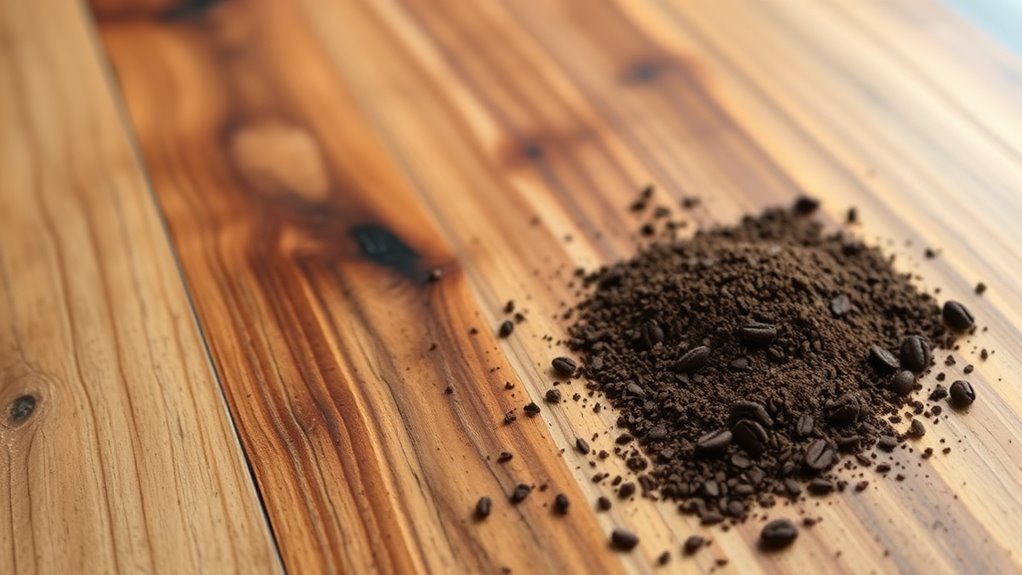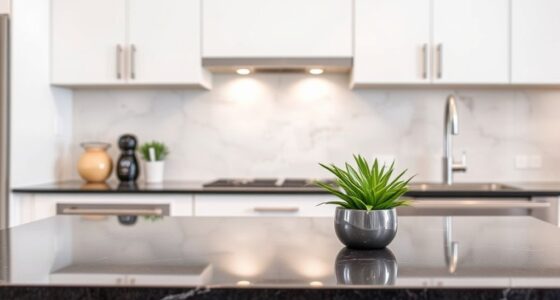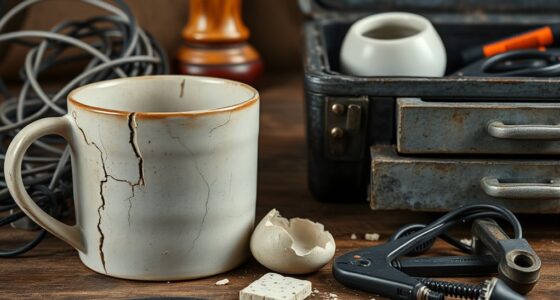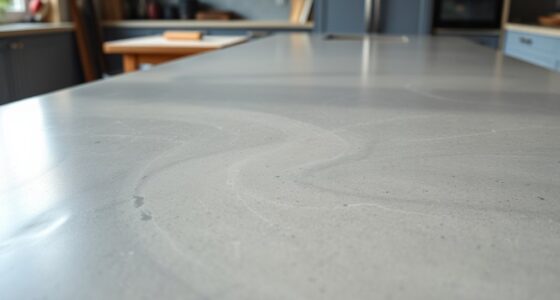You can refinish wood furniture using coffee grounds by creating a natural stain or cleaner. Mix used grounds with water or oil to form a paste, then gently scrub or apply it to the wood for a warm, rich hue. Coffee grounds are biodegradable and eco-friendly, offering a sustainable way to enhance and restore furniture without harsh chemicals. Curious about how well this works and tips for success? Keep exploring to find out more.
Key Takeaways
- Coffee grounds can be used as a natural cleaner and stain for wood furniture, offering an eco-friendly alternative.
- Creating a paste from coffee grounds and water or oil helps gently clean or add a warm stain to wood surfaces.
- Strained brewed coffee acts as a natural wood stain, providing a deep, warm hue that enhances wood grain.
- Always test on small or hidden areas first to ensure even application and desired color results.
- Sealing with beeswax or oil-based finishes preserves the natural look and prolongs the durability of the restored furniture.
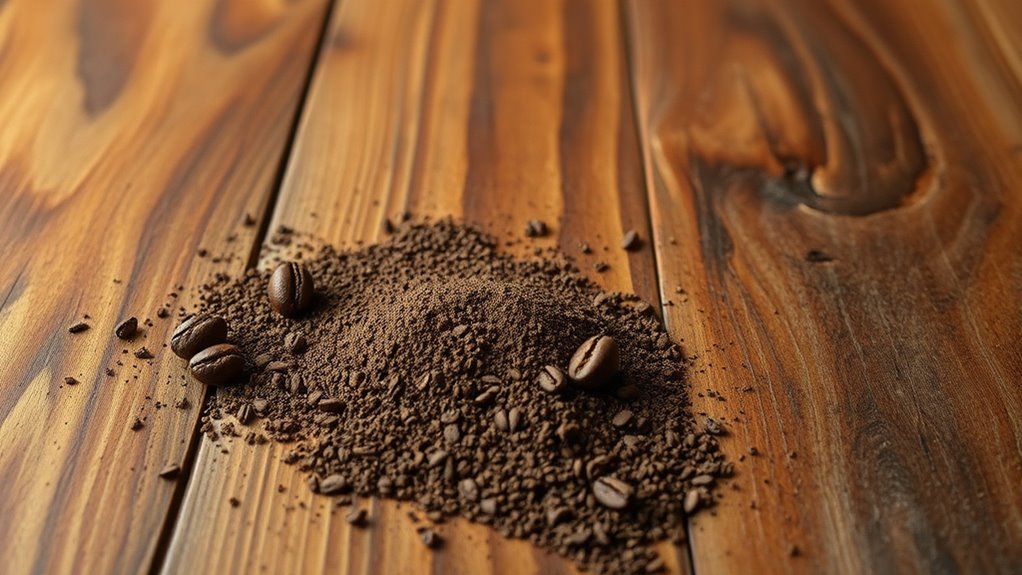
Refinishing wood furniture with coffee grounds offers an eco-friendly and budget-friendly way to restore its appearance. This method taps into eco-friendly methods that reduce waste while giving your furniture a refreshed look. Coffee grounds, often discarded after brewing, can serve as an abrasive cleaning agent or even a stain, making them a versatile tool in your furniture restoration techniques. By repurposing coffee grounds, you not only cut down on waste but also avoid harsh chemicals typically found in commercial refinishing products.
Refinish furniture eco-friendly by repurposing coffee grounds as a natural cleaner or stain, reducing waste and avoiding harsh chemicals.
When you consider furniture restoration techniques, it’s essential to think about how environmentally conscious your approach is. Coffee grounds are natural and biodegradable, which means they won’t harm the environment when used properly. To utilize them effectively, you might start by mixing used coffee grounds with a little water or oil to create a paste. This paste can be gently rubbed onto the wood surface to clean away grime or bring out the wood’s natural grain. The gritty texture helps lift dirt without scratching the surface, making it a gentle yet effective cleaning method.
If you’re interested in staining your furniture with coffee grounds, you can experiment with creating a natural stain. Boil the grounds in water to extract the coffee’s rich color, then strain the liquid and apply it with a cloth or brush. The result is a deep, warm hue that enhances the wood’s natural beauty. This approach aligns perfectly with eco-friendly methods because it uses natural substances instead of chemical stains. Keep in mind, though, that this type of stain may not be as uniform or long-lasting as commercial options, so you might need to seal the surface afterward with a natural finish like beeswax or an oil-based product.
Using coffee grounds in furniture restoration also offers a tactile experience—applying the paste or stain feels satisfying and engaging. Plus, it’s affordable; most households already have coffee grounds on hand. You can test out this method on small, inconspicuous areas first to see how the wood reacts. If you’re worried about staining unevenly, practice with scrap wood or old furniture pieces.
Frequently Asked Questions
How Long Does the Coffee Ground Finish Typically Last?
The durability lifespan of a coffee ground finish varies depending on usage and care, but you can expect it to last around 1 to 3 years with proper maintenance. To extend its lifespan, you should regularly clean and reseal the surface, avoiding excessive moisture or scratches. While it’s an eco-friendly option, keep in mind that it might require more frequent touch-ups compared to traditional finishes to maintain its appearance.
Can Coffee Grounds Stain All Types of Wood Evenly?
You might wonder if coffee grounds stain all wood types evenly. Natural wood tends to absorb the stain more uniformly, offering better color consistency, while synthetic or treated woods can resist even staining, leading to uneven color. Coffee grounds can create a charming, rustic look, but for the most uniform results, natural wood is your best bet, as it allows for better color uniformity compared to synthetic options.
Is This Method Suitable for Outdoor Furniture?
You might consider using coffee grounds on outdoor furniture, but it’s not the best choice for weather resistance. Coffee grounds are eco-friendly alternatives, but they don’t provide the durability needed for outdoor conditions. Exposure to rain and sun can wash away or damage the finish. For outdoor furniture, look for weather-resistant finishes designed to withstand the elements, ensuring your furniture stays protected and eco-friendly over time.
Are There Any Health Risks Using Coffee Grounds on Furniture?
You might wonder about health concerns when using coffee grounds on furniture. Typically, coffee grounds are safe and non-toxic, but some people worry about ingredient safety, especially if you have allergies or sensitive skin. Keep in mind that used coffee grounds aren’t harmful, but avoid inhaling dust or putting them in your mouth. Overall, if you handle them properly, there’s minimal risk to your health.
How Does Coffee Ground Finishing Compare to Traditional Staining?
When comparing coffee ground finishing to traditional staining, you find that coffee grounds offer an eco-friendly alternative for DIY home projects. Coffee grounds create a natural,Unique finish that’s less toxic and more sustainable. While traditional stains may provide more consistent color, coffee grounds allow you to customize shades and add texture. You get a creative, environmentally conscious option that’s easy to apply, making your furniture refinishing both fun and eco-friendly.
Conclusion
So, refinish your wood furniture with coffee grounds? Absolutely! It’s a simple, eco-friendly trick that works surprisingly well—no need for harsh chemicals. Sure, some might worry about staining unevenly, but if you apply sparingly and test first, you’ll get a beautiful, rustic finish. Don’t hesitate to give it a try; coffee grounds can add warmth and character to your piece, making it unique without the fuss of traditional methods.
